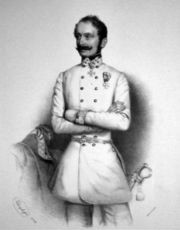Benedek was born in Sopron (a Hungarian town 60 km from Vienna, known in German as Ödenburg) the son of a doctor. He was trained at the Theresiana Military Academy in Vienna-Neustadt. He began his military career in 1822 in the 27th infantry regiment of the Austrian Imperial Army, becoming First Lieutenant in 1833 at headquarters in the Army of Italy and Captain in 1835, then aged 31.
Five years later he was promoted to Major and ADC to the General Commander of Galicia. Still Galicia in 1843, he was again promoted to Lieutenant-Colonel and received the Knight's Cross (Ritterkreuz) of the Order of Leopold (as well as a simultaneous promotion to the rank of Colonel) for suppressing an uprising in Western Galicia near Crakow (Gdow and Wieliczka) in 1846.
In August 1847, Benedek was given command of the 33rd “Graf Gyulai” infantry regiment in Italy. On 5 April 1848 he took command of a newly formed brigade distinguishing himself notably at Curtatone on 29 May, 1848, for which he was awarded the Order of Maria Theresia. On the following day, Benedek led his troops in the Battle of Goito.
Benedek was afterwards awarded the Commanders' Cross of the Order of Leopold, and the Knight's Cross of the Military Order of Maria Theresa. This officially made Benedek a knight (hence Ludwig, Ritter von Benedek).
In the campaign of 1849, he distinguished himself at the taking of Mortara (21 March) and the the Battle of Novara. Archduke Albrecht, Benedek's divisional commander, was to describe him as a warrior such as those who fought under his father, Archduke Karl, the victor at Aspern. On April 3, 1849, he became Major General and was appointed to the staff of the Chief of Quartermaster-General with the 2nd Army in Italy.
Benedek was then sent to Hungary to help end the Revolution there. His troops put down the uprising in Raab (Györ). After becoming wounded at a subsequent encounter, at Szőny, he was given the Military Merit Cross, made Regimental Colonel of the 2nd Army, and then sent back to Italy as chief of staff to Radetzky. In 1852, he was promoted to Feldmarschalleutnant and in 1854 he was given command over the IV Armeekorps in Lemberg, the Austrian army of observation sent to Galicia during the Crimean War.
When Radetzky retired in 1857, Benedek became the Commander of the II Army Corps.
In early 1859, Benedek took command of the VIIIth army corps in Italy, based in Cremona. On 27 May, 1859, he was promoted to the rank of Feldzeugmeister, second in command of the entire Austrian Army. On 24 June, at the battle of Solferino, Benedek had a position on the far right of the Austrian line outside Pozzolengo, facing Piedmontese/Sardinian regiments commanded by Cucchiari, Fanti, Mollard and Durando. He fought these troops around the village of San Martino until 9 in the evening. He was finally forced to help in the retreat of the main defeated Austrian army under Franz Joseph I, abandoning San Martino to the Piedmontese. Before the end of the year he was awarded the Kommandeurskreuz of the Order of Maria Theresia for his bravery on that day. On 30 January, 1860, Benedek was appointed Chief of the Generalquartiermeisterstab, and on 19 April, 1860, he became civilian and military governor of Hungary. On 20 October, 1860, he was appointed Oberkommandant of Austria troops in Venetia and the Alpine regions and was awarded the Grand Cross of the Order of Leopold with War Decoration on 14 January, 1862. On 18 April, 1861, he was made a life member of the Austrian parliament.
On the outbreak of the Austro-Prussian War in 1866, Benedek was made Commander-in-Chief of the Northern Army, an appointment he did not want, claiming that he knew neither the terrain in the north nor the enemy. At the battle of Königgrätz (Hradec Králové) he was to manoeuvre poorly, be outflanked by the Prussian army and so be decisively defeated. Armistice was signed three weeks later and Benedek retreated with the rump of his army into Hungary. Full responsibility for the defeat fell upon Benedek and he resigned as Commander-in-Chief at Pressburg (Bratislava) on 26 July, 1866 – he was replaced by Archduke Albrecht. A court martial was begun but shelved on the Austrian emperor's request. Deeply affected by these events, Benedek went into retirement at Graz, and died there on 27 April, 1881.
P.H. June 2009
Bibliography
Heinrich Friedjung (ed.), Benedeks Nachgelassene Papieren, Carl Reißner, Dresden 1904. James G. Huckenpöhler, From Cracow to Königgrätz: Feldzeugmeister Ludwig Ritter von Benedek and the shifting balance of power in Central Europe, Washington, 1990
John Presland, Vae victis. The life of Ludwig von Benedek, 1804 – 1881, London, 1934
Emil Schmedes, Geschichte des k. k. 28. Infanterie-Regimentes F. Z. M. Ludwig Ritter von Benedek, Wien, 1878
Constantin v. Wurzbach, Biographisches Lexikon des Kaiserthums Österreich. Band II., Zamarski, Wien, 1861
Oscar Criste, Benedek, Ludwig von, in Allgemeine Deutsche Biographie (ADB). Band 46, Duncker & Humblot, Leipzig 1902, p. 351–354
Oskar Regele, Benedek, Ludwig von, in Neue Deutsche Biographie (NDB). Band 2, Duncker & Humblot, Berlin 1955, p. 42 f.


